Peanut Free Pad Thai: Craving the vibrant flavors of Thailand but navigating a peanut allergy? You’re in the right place! Imagine twirling perfectly cooked rice noodles coated in a tangy, savory sauce, bursting with fresh vegetables and succulent shrimp all without a single peanut in sight. This isn’t just a recipe; it’s a culinary passport to Southeast Asia, reimagined for everyone to enjoy.
Pad Thai, a dish synonymous with Thai cuisine, has a fascinating history. It was popularized in the mid-20th century as part of a national identity campaign, designed to promote unity and reduce rice consumption. While traditionally featuring peanuts for their rich flavor and textural contrast, the beauty of Pad Thai lies in its adaptability.
People adore Pad Thai for its harmonious blend of sweet, sour, and savory notes. The chewy noodles, the crisp bean sprouts, the bright lime, and the umami-packed sauce create a symphony of flavors and textures that dance on your palate. And let’s be honest, its quick cooking time makes it a perfect weeknight meal. But what if you or someone you love has a peanut allergy? That’s where this Peanut Free Pad Thai recipe shines. We’ve carefully crafted a delicious and authentic-tasting version that captures the essence of Pad Thai without compromising on flavor or safety. Get ready to experience the magic of Thailand, one delicious, peanut-free bite at a time!
Ingredients:
- For the Noodles:
- 1 pound wide rice noodles (about ¼ inch wide)
- Water for soaking
- For the Sauce:
- ½ cup tamarind paste
- ½ cup fish sauce (or soy sauce for vegetarian option)
- ¼ cup palm sugar (or brown sugar)
- 2 tablespoons rice vinegar
- 1 tablespoon soy sauce (if not using as fish sauce substitute)
- 1 teaspoon sriracha (or more, to taste)
- For the Stir-Fry:
- 2 tablespoons vegetable oil
- 4 cloves garlic, minced
- 1 small shallot, thinly sliced
- 1 pound boneless, skinless chicken breasts, cut into bite-sized pieces (or tofu for vegetarian option)
- 1 cup shrimp, peeled and deveined (optional, omit for vegetarian/vegan)
- 2 large eggs, lightly beaten
- 1 cup bean sprouts
- ½ cup firm tofu, cubed (optional, but recommended)
- ½ cup Chinese chives, cut into 1-inch pieces (or green onions)
- ½ cup roasted unsalted cashews, chopped (or sunflower seeds for nut-free)
- For Garnish:
- Lime wedges
- Fresh cilantro leaves
- Extra chopped cashews/sunflower seeds
- Sriracha (optional)
Preparing the Noodles:
The key to perfect Pad Thai starts with perfectly prepared noodles. If you overcook them, they’ll be mushy. If you undercook them, they’ll be tough. Here’s how I get them just right:
- Soak the Noodles: Place the rice noodles in a large bowl and cover them with warm water. Let them soak for about 30-45 minutes, or until they are pliable but still firm. You want them to be flexible enough to bend without breaking, but not so soft that they fall apart. The soaking time will depend on the thickness of your noodles, so keep an eye on them.
- Drain the Noodles: Once the noodles are properly soaked, drain them well in a colander. Give them a good shake to remove any excess water. This is important because too much water will make your Pad Thai soggy.
- Prevent Sticking: To prevent the noodles from sticking together while you prepare the other ingredients, you can toss them with a teaspoon of vegetable oil. This will help keep them separate and ready to go when it’s time to stir-fry.
Making the Pad Thai Sauce:
The sauce is the heart and soul of Pad Thai. It’s what gives it that signature sweet, sour, and savory flavor. Don’t be tempted to skip any of the ingredients they all play a crucial role in creating the perfect balance.
- Combine the Ingredients: In a medium bowl, whisk together the tamarind paste, fish sauce (or soy sauce), palm sugar (or brown sugar), rice vinegar, soy sauce (if using), and sriracha.
- Adjust to Taste: Taste the sauce and adjust the ingredients to your liking. If it’s too sour, add a little more sugar. If it’s not salty enough, add a little more fish sauce (or soy sauce). If you want it spicier, add more sriracha. Remember, you can always add more, but you can’t take it away!
- Set Aside: Once you’re happy with the flavor, set the sauce aside until you’re ready to stir-fry the Pad Thai.
Stir-Frying the Pad Thai:
Now for the fun part! This is where all the flavors come together in a sizzling, aromatic symphony. Be sure to have all your ingredients prepped and ready to go before you start, as the stir-frying process moves quickly.
- Heat the Oil: Heat the vegetable oil in a large wok or skillet over medium-high heat. Make sure the wok is hot before adding the oil, and let the oil heat up before adding the garlic and shallots.
- Sauté the Aromatics: Add the minced garlic and thinly sliced shallot to the hot oil and sauté for about 30 seconds, or until fragrant. Be careful not to burn the garlic, as it can become bitter.
- Cook the Protein: Add the chicken (or tofu) and shrimp (if using) to the wok and cook until the chicken is cooked through and the shrimp are pink and opaque. This should take about 5-7 minutes, depending on the size of the chicken pieces and shrimp.
- Scramble the Eggs: Push the chicken and shrimp to one side of the wok and pour the beaten eggs into the empty space. Scramble the eggs until they are cooked through but still slightly moist.
- Add the Noodles: Add the soaked and drained rice noodles to the wok and toss them with the chicken, shrimp, eggs, garlic, and shallots. Make sure the noodles are evenly distributed throughout the wok.
- Pour in the Sauce: Pour the Pad Thai sauce over the noodles and toss everything together until the noodles are evenly coated with the sauce.
- Add the Remaining Ingredients: Add the bean sprouts, tofu (if using), and Chinese chives (or green onions) to the wok and toss everything together until the bean sprouts are slightly wilted and the chives are tender-crisp.
- Finish and Serve: Remove the wok from the heat and stir in the chopped cashews (or sunflower seeds). Serve the Pad Thai immediately, garnished with lime wedges, fresh cilantro leaves, extra chopped cashews/sunflower seeds, and sriracha (if desired).
Tips for the Best Pad Thai:
- Use Wide Rice Noodles: Wide rice noodles are the traditional choice for Pad Thai, and they hold the sauce better than thinner noodles.
- Don’t Overcook the Noodles: Overcooked noodles will be mushy and unappetizing. Be sure to soak them until they are pliable but still firm.
- Use Palm Sugar: Palm sugar has a unique caramel-like flavor that adds depth to the Pad Thai sauce. If you can’t find palm sugar, you can substitute brown sugar.
- Don’t Be Afraid to Adjust the Sauce: The Pad Thai sauce is all about balance. Don’t be afraid to adjust the ingredients to your liking until you achieve the perfect sweet, sour, and savory flavor.
- Work Quickly: Stir-frying is a fast-paced cooking method. Be sure to have all your ingredients prepped and ready to go before you start.
- Serve Immediately: Pad Thai is best served immediately, while the noodles are still warm and the sauce is still glistening.
Variations:
Pad Thai is a versatile dish that can be easily customized to your liking. Here are a few variations to try:
- Vegetarian Pad Thai: Substitute tofu for the chicken and shrimp, and use soy sauce instead of fish sauce. You can also add extra vegetables, such as broccoli, carrots, or bell peppers.
- Vegan Pad Thai: In addition to the vegetarian substitutions, omit the eggs or use a vegan egg substitute.
- Spicy Pad Thai: Add more sriracha to the sauce, or sprinkle some chili flakes over the finished dish.
- Seafood Pad Thai: Add other types of seafood, such as scallops, mussels, or squid.
- Chicken Pad Thai: Use only chicken as the protein source.
- Shrimp Pad Thai: Use only shrimp as the protein source.
Ingredient Substitutions:
Sometimes you might not have all the ingredients on hand. Here are some substitutions you can make:
- Tamarind Paste: If you can’t find tamarind paste, you can substitute a mixture of lime juice and brown sugar. Use about 2 tablespoons of lime juice and 1 tablespoon of brown sugar for every ¼ cup of tamarind paste.
- Fish Sauce: If you don’t have fish sauce, you can substitute soy sauce. However, fish sauce has a unique flavor that soy sauce can’t quite replicate. You might want to add a pinch of salt to the soy sauce to compensate.
- Palm Sugar: If you can’t find palm sugar, you can substitute brown sugar.
- Chinese Chives: If you can’t find Chinese chives, you can substitute green onions.
-
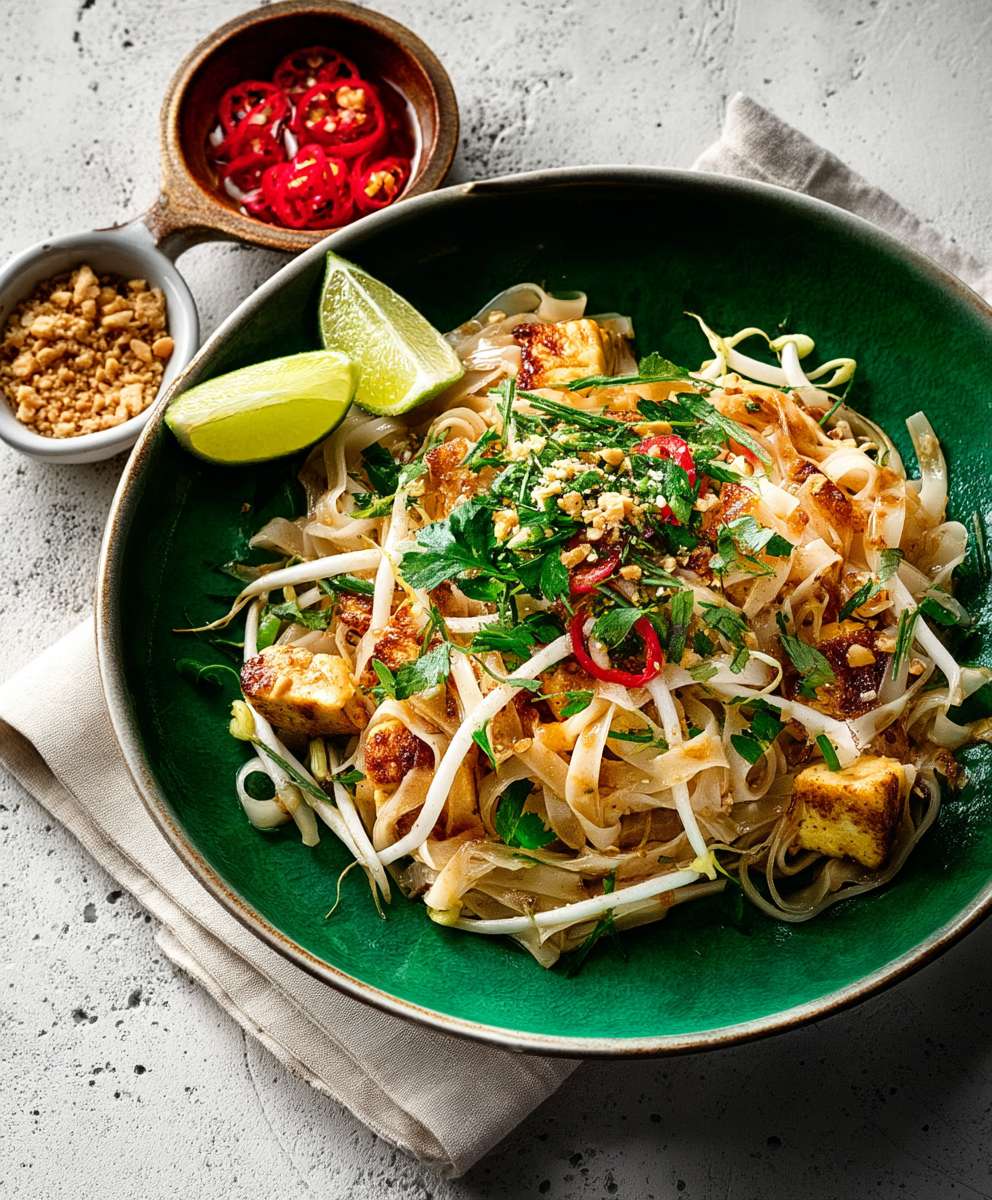
Conclusion:
This Peanut Free Pad Thai isn’t just a recipe; it’s a passport to a vibrant, flavorful world, all without the worry of peanuts! I truly believe this recipe is a must-try for anyone seeking a delicious and accessible Asian-inspired meal. The perfectly balanced sweet, sour, and savory notes, combined with the satisfying chew of the noodles and the delightful crunch of the vegetables, create a symphony of textures and tastes that will leave you craving more.
But why is it a must-try, you ask? Beyond the obvious allergy-friendly aspect, this recipe is incredibly versatile and easy to customize to your liking. It’s quicker than ordering takeout, healthier than most restaurant versions, and, dare I say, even more delicious! The homemade sauce is the star of the show, and once you master it, you’ll find yourself using it in countless other dishes.
Think of this recipe as a blank canvas for your culinary creativity. Feel free to swap out the shrimp for chicken, tofu, or even just load it up with extra vegetables for a vegetarian feast. If you’re feeling adventurous, try adding a touch of heat with a pinch of red pepper flakes or a drizzle of sriracha.
Serving Suggestions and Variations:
* Garnish Galore: Don’t underestimate the power of a good garnish! A sprinkle of chopped cilantro, a squeeze of lime juice, and a scattering of bean sprouts will elevate your Pad Thai to restaurant-quality.
* Protein Power: As mentioned, shrimp is fantastic, but grilled chicken, crispy tofu, or even scrambled eggs are excellent alternatives.
* Veggie Variety: Get creative with your vegetables! Bell peppers, broccoli florets, snap peas, or even shredded carrots would be delicious additions.
* Spice It Up: If you like a little heat, add a pinch of red pepper flakes to the sauce or serve with a side of sriracha.
* Nutty Alternatives: While this recipe is peanut-free, you can still add a nutty element by using sunflower seeds, pumpkin seeds, or even toasted sesame seeds for a delightful crunch.
* Make it a Meal Prep Masterpiece: This Pad Thai is also great for meal prepping! Simply cook the noodles and sauce separately, then combine them with your protein and vegetables when you’re ready to eat. It will last for up to 3 days in the refrigerator.I’ve poured my heart into perfecting this Peanut Free Pad Thai recipe, and I’m confident that you’ll love it as much as I do. It’s a dish that’s perfect for a weeknight dinner, a weekend gathering, or even a special occasion. It’s a crowd-pleaser that’s sure to impress, and it’s a recipe that you’ll find yourself making again and again.
So, what are you waiting for? Gather your ingredients, put on your apron, and get ready to embark on a culinary adventure. I promise you won’t be disappointed. And most importantly, I want to hear about your experience! Did you make any modifications? Did you add any special ingredients? What did your family and friends think? Share your photos and stories in the comments below. I can’t wait to see your creations and hear about your Pad Thai triumphs! Happy cooking!
Peanut Free Pad Thai: Delicious and Safe Recipe
Classic Pad Thai with rice noodles, chicken, shrimp, and a tangy tamarind sauce. A delicious and customizable Thai stir-fry!
Ingredients
- 1 pound wide rice noodles (about ¼ inch wide)
- Water for soaking
- ½ cup tamarind paste
- ½ cup fish sauce (or soy sauce for vegetarian option)
- ¼ cup palm sugar (or brown sugar)
- 2 tablespoons rice vinegar
- 1 tablespoon soy sauce (if not using as fish sauce substitute)
- 1 teaspoon sriracha (or more, to taste)
- 2 tablespoons vegetable oil
- 4 cloves garlic, minced
- 1 small shallot, thinly sliced
- 1 pound boneless, skinless chicken breasts, cut into bite-sized pieces (or tofu for vegetarian option)
- 1 cup shrimp, peeled and deveined (optional, omit for vegetarian/vegan)
- 2 large eggs, lightly beaten
- 1 cup bean sprouts
- ½ cup firm tofu, cubed (optional, but recommended)
- ½ cup Chinese chives, cut into 1-inch pieces (or green onions)
- ½ cup roasted unsalted cashews, chopped (or sunflower seeds for nut-free)
- Lime wedges
- Fresh cilantro leaves
- Extra chopped cashews/sunflower seeds
- Sriracha (optional)
Instructions
- Soak the Noodles: Place the rice noodles in a large bowl and cover them with warm water. Let them soak for about 30-45 minutes, or until they are pliable but still firm. Drain well in a colander and toss with 1 teaspoon of vegetable oil to prevent sticking.
- Make the Sauce: In a medium bowl, whisk together the tamarind paste, fish sauce (or soy sauce), palm sugar (or brown sugar), rice vinegar, soy sauce (if using), and sriracha. Adjust to taste.
- Stir-Fry: Heat the vegetable oil in a large wok or skillet over medium-high heat. Add the minced garlic and thinly sliced shallot and sauté for about 30 seconds, or until fragrant.
- Add the chicken (or tofu) and shrimp (if using) to the wok and cook until the chicken is cooked through and the shrimp are pink and opaque (5-7 minutes).
- Push the chicken and shrimp to one side of the wok and pour the beaten eggs into the empty space. Scramble the eggs until they are cooked through but still slightly moist.
- Add the soaked and drained rice noodles to the wok and toss them with the chicken, shrimp, eggs, garlic, and shallots.
- Pour the Pad Thai sauce over the noodles and toss everything together until the noodles are evenly coated with the sauce.
- Add the bean sprouts, tofu (if using), and Chinese chives (or green onions) to the wok and toss everything together until the bean sprouts are slightly wilted and the chives are tender-crisp.
- Remove the wok from the heat and stir in the chopped cashews (or sunflower seeds).
- Serve immediately, garnished with lime wedges, fresh cilantro leaves, extra chopped cashews/sunflower seeds, and sriracha (if desired).
Notes
- Use wide rice noodles for the best texture.
- Don’t overcook the noodles; they should be pliable but still firm.
- Palm sugar adds a unique flavor, but brown sugar can be substituted.
- Adjust the sauce to your liking for the perfect balance of sweet, sour, and savory.
- Have all ingredients prepped before starting the stir-fry process.
- Serve immediately for the best flavor and texture.
- Variations: Vegetarian (tofu, soy sauce), Vegan (omit eggs or use vegan substitute), Spicy (more sriracha), Seafood (add other seafood), Chicken only, Shrimp only.
- Substitutions: Tamarind paste (lime juice and brown sugar), Fish sauce (soy sauce), Palm sugar (brown sugar), Chinese chives (green onions).

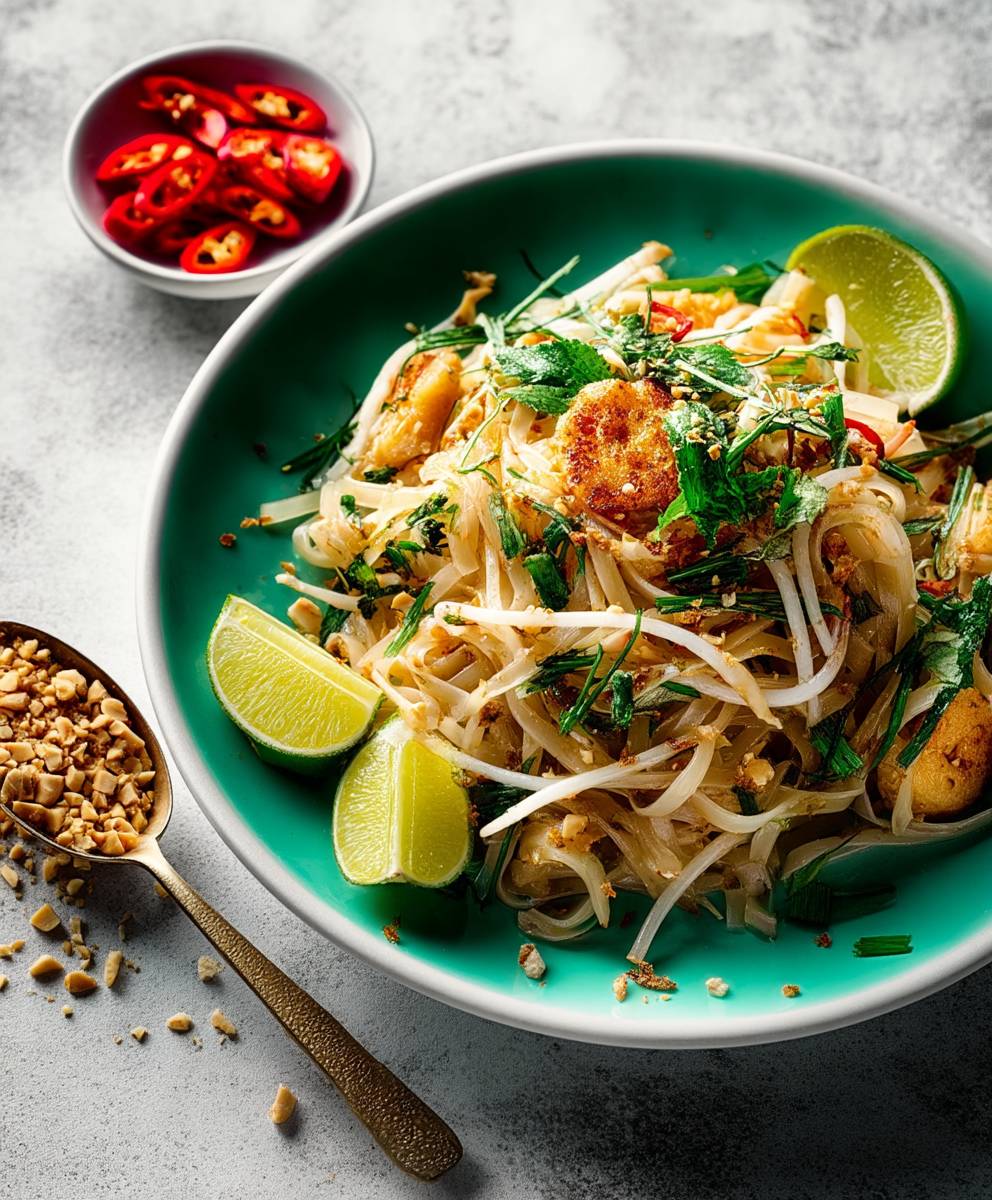
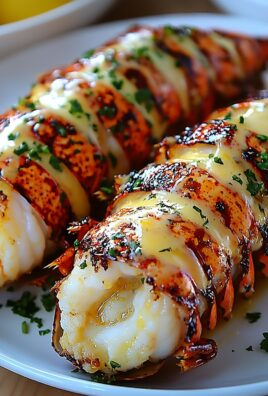
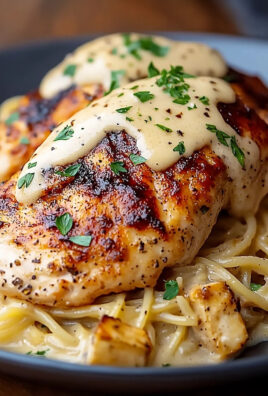
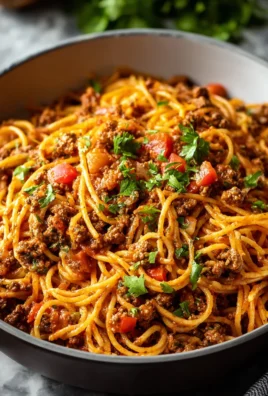
Leave a Comment